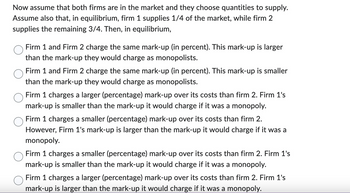and the cost function of the second firm is , where are all positive parameters. The demand function in this industry is where α C(q₁) = A * qu C(92) = Bq₂ (A, B, a, ß) Q = Dp (D,y) Now assume that both firms are in the market and they choose quantities to supply. Assume also that, in equilibrium, firm 1 supplies 1/4 of the market, while firm 2 supplies the remaining 3/4. Then, in equilibrium, Firm 1 and Firm 2 charge the same mark-up (in percent). This mark-up is larger than the mark-up they would charge as monopolists. Firm 1 and Firm 2 charge the same mark-up (in percent). This mark-up is smaller than the mark-up they would charge as monopolists. Firm 1 charges a larger (percentage) mark-up over its costs than firm 2. Firm 1's mark-up is smaller than the mark-up it would charge if it was a monopoly. Firm 1 charges a smaller (percentage) mark-up over its costs than firm 2. However, Firm 1's mark-up is larger than the mark-up it would charge if it was a monopoly. Firm 1 charges a smaller (percentage) mark-up over its costs than firm 2. Firm 1's mark-up is smaller than the mark-up it would charge if it was a monopoly. Firm 1 charges a larger (percentage) mark-up over its costs than firm 2. Firm 1's mark-up is larger than the mark-up it would charge if it was a monopoly.
and the cost function of the second firm is , where are all positive parameters. The demand function in this industry is where α C(q₁) = A * qu C(92) = Bq₂ (A, B, a, ß) Q = Dp (D,y) Now assume that both firms are in the market and they choose quantities to supply. Assume also that, in equilibrium, firm 1 supplies 1/4 of the market, while firm 2 supplies the remaining 3/4. Then, in equilibrium, Firm 1 and Firm 2 charge the same mark-up (in percent). This mark-up is larger than the mark-up they would charge as monopolists. Firm 1 and Firm 2 charge the same mark-up (in percent). This mark-up is smaller than the mark-up they would charge as monopolists. Firm 1 charges a larger (percentage) mark-up over its costs than firm 2. Firm 1's mark-up is smaller than the mark-up it would charge if it was a monopoly. Firm 1 charges a smaller (percentage) mark-up over its costs than firm 2. However, Firm 1's mark-up is larger than the mark-up it would charge if it was a monopoly. Firm 1 charges a smaller (percentage) mark-up over its costs than firm 2. Firm 1's mark-up is smaller than the mark-up it would charge if it was a monopoly. Firm 1 charges a larger (percentage) mark-up over its costs than firm 2. Firm 1's mark-up is larger than the mark-up it would charge if it was a monopoly.
Oh no! Our experts couldn't answer your question.
Don't worry! We won't leave you hanging. Plus, we're giving you back one question for the inconvenience.
Submit your question and receive a step-by-step explanation from our experts in as fast as 30 minutes.
You have no more questions left.
Message from our expert:
Our experts need more information to provide you with a solution. Please resubmit your question, making sure it's detailed and complete. We've credited a question to your account.
Your Question:

Transcribed Image Text:and the cost function of the second firm is
, where
are all positive parameters.
The demand function in this industry is
where
α
C(q₁) = A * qu
C(92) = Bq₂
(A, B, a, ß)
Q = Dp
(D,y)

Transcribed Image Text:Now assume that both firms are in the market and they choose quantities to supply.
Assume also that, in equilibrium, firm 1 supplies 1/4 of the market, while firm 2
supplies the remaining 3/4. Then, in equilibrium,
Firm 1 and Firm 2 charge the same mark-up (in percent). This mark-up is larger
than the mark-up they would charge as monopolists.
Firm 1 and Firm 2 charge the same mark-up (in percent). This mark-up is smaller
than the mark-up they would charge as monopolists.
Firm 1 charges a larger (percentage) mark-up over its costs than firm 2. Firm 1's
mark-up is smaller than the mark-up it would charge if it was a monopoly.
Firm 1 charges a smaller (percentage) mark-up over its costs than firm 2.
However, Firm 1's mark-up is larger than the mark-up it would charge if it was a
monopoly.
Firm 1 charges a smaller (percentage) mark-up over its costs than firm 2. Firm 1's
mark-up is smaller than the mark-up it would charge if it was a monopoly.
Firm 1 charges a larger (percentage) mark-up over its costs than firm 2. Firm 1's
mark-up is larger than the mark-up it would charge if it was a monopoly.
Knowledge Booster
Learn more about
Need a deep-dive on the concept behind this application? Look no further. Learn more about this topic, economics and related others by exploring similar questions and additional content below.Recommended textbooks for you

Managerial Economics: Applications, Strategies an…
Economics
ISBN:
9781305506381
Author:
James R. McGuigan, R. Charles Moyer, Frederick H.deB. Harris
Publisher:
Cengage Learning

Managerial Economics: Applications, Strategies an…
Economics
ISBN:
9781305506381
Author:
James R. McGuigan, R. Charles Moyer, Frederick H.deB. Harris
Publisher:
Cengage Learning
